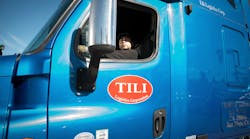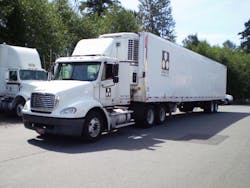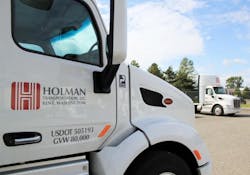Smaller, over-the-road truck fleets can successfully compete against larger—not to mention mega-sized—motor carriers if their owners think and act big by fully leveraging the reduced footprint of their operations. It’s well known that persons of small stature who use what they’ve learned to earn black belts in martial arts can easily take down bigger, stronger assailants. Just like that, managers of smaller carriers can not only keep a toehold in today’s freight marketplace, but gain the upper hand when they’re smart enough to recognize opportunities they can exploit to their advantage.
Here, then, are profiles of a dynamic trio of smaller fleets whose recent experiences amply demonstrate that what matters isn’t the number of trucks you run, but how smart you run with them.
TILI Logistics: Building on a niche
According to Sergio Casas Silva Jr., operations manager for TILI Logistics, the San Diego-based nationwide carrier got its start back in 2007 as a regional carrier hauling manufactured goods from the free-trade zone (a maquiladora) across the border in Mexico into Southern California. TILI was started by his father, Sergio Casas Silva Sr. From that initial niche, the fleet began expanding; first to Northern California on its way to becoming the 48-state coast-to-coast operation it is today.
“We quickly developed a reputation for safe, dependable delivery of electronic components,” Silva relates, “and from there, the opportunity to expand our services throughout the U.S. soon presented itself.
“Our operation is structured around our home base, and 90% to 95% of what we haul out of there is electronics,” he elaborates. “That’s the niche that helped establish us. Electronics is a high-value, highly sensitive type of freight. As we demonstrated that we ran a dependable and secure operation, we captured more of that business.”
Silva adds that starting out, TILI was well aware both that electronics manufacturers pay a premium for hauling their goods, and there is less competition from other carriers for this lucrative business. What’s more, since electronics are light to haul, the fleet uses less fuel to move them.
Today, TILI is still engaged in hauling electronics from various maquiladoras but also is moving such freight by the container load from West Coast ports. Thanks to the costly nature of their loads, Silva says these shippers tend to “keep close to the vest” the names of the carriers they employ. But he cites a Samsung facility in nearby Tijuana as a typical outbound-freight customer.
“As much as we have established high-value clients to load us out of the West Coast,” Silva relates, “we built up our cross-country operation by depending on brokers to load us back up on the East Coast.”
When TILI started pushing East, it “worked first to determine which would be the best brokers to work with in different regions across the country,” Silva continues. “Now, we’ve grown to the point where we can work directly with shippers elsewhere in the country as well. Still, their freight and our trucks do not always align and by using brokers, we continue to cut down on deadheading.”
He also says building a strong relationship with a factoring company has been essential to growing the operation. “Liquidity is a critical element in trucking. We use National Bankers Trust’s factoring services so we can look past the limitations of tight cash flow. It lets us avoid issues around driver pay, and when it comes time to invest in drivers or equipment, we can.”
Driver strategy
Belying both the quality of its outbound customers and the cross-country scope of its operation, TILI currently operates just 30 tractors. “We run 50 company trailers as we deliver a lot of new trailers for Hyundai Translead,” points out Silva. That OEM builds van and reefer trailers destined for the U.S. at three plants in Tijuana and relies on TILI to help get them to market here.
Certainly one advantage of running small is that TILI can hew comfortably to its “one-driver strategy,” which pays dividends in several key ways. “Assigning drivers to their own truck helps ensure each truck is well cared for,” Silva explains. “By not having to remove their things, drivers get a sense of ownership about what is truly their second home. And that helps as well with driver retention.
“Keeping good drivers is the lifeblood of the company,” he continues. “That’s why we pay them quickly and in full and keep our trucks well maintained for their comfort.”
All the trucks TILI runs are late-model units purchased used. Silva says the fleet ran just seven trucks as of November 2012 and expanded to its present size by July 2013 with the addition of 25 2008-2009 mode-year Freightliner Cascadia and Century tractors.
The trucks they purchased had been operated by “respected nationwide carriers,” he points out. “We bought just two specific models so we could get to know the new trucks inside and out.”
Silva says with those trucks, TILI quickly “advanced into the technology-oriented era of trucking. That led to increasing our maintenance staff to two mechanics and a supervisor as well as using outside consultants as needed.
“We went through our hardships with the new engine technology,” Silva admits. “But we accepted that these types of vehicles would drive the future of the company as a nationwide operation, and we committed to learning how to care for them.”
TILI has embraced other technology as well. For example, it has Networkfleet’s GPS-based tracking and engine-diagnostics system on each truck. Along with tracking vehicle location and performance, Silva credits the solution with helping “identify which vehicles run most efficiently and which drivers stay on schedule and run the best routes.”
As for where TILI is headed next, Silva says the plan is to expand to 55 trucks by year’s end. “That would be a game-changer for us, both in terms of growing our revenue and in how we operate,” he states. “Our main clientele are the biggest cheerleaders for us to grow and that confidence motivates us. We want to become as big as we can—but always with our eyes open to what growth will entail.”
National Food Corp: Not in one basket
While Everett, WA-based National Food Corp. (NFC) lays claim to being the Northwest’s leading producer of organic and cage-free eggs, its fleet provides refrigerated and dry-van truckload and LTL services throughout the Northwest to outside firms.
According to transportation manager Kevin Bookey, his father (who retired in 1991) and his uncle launched the private fleet operation back in 1956 to get the family farm’s eggs to market by delivering them to major retailers, food-distribution firms, and even mom-and-pop stores.
Today, the fleet is truly multi-purpose, as it’s charged with hauling live chickens and feed to NFC’s farms and fresh eggs from there to its processing plants, if processing is not done right at a farm. Delivery to customers, including distribution centers, is also still a big item on the menu.
Bookey says NFC’s sales territory is concentrated in Washington and Oregon, but there is also “significant activity in Idaho, Montana, the Dakotas, Nebraska and Iowa.”
While NFC’s egg-farming rests on an 800,000-bird capacity and its facilities (including chicken farms, egg-processing plants and distribution centers) are “sprinkled around the Northwest” as well as sited as far away as the central Midwest, the fleet operates just 42 tractors, 100 trailers and 6 straight trucks, although it does use some outside carriers too.
The fleet is primarily maintained in-house by a team of mechanics who have been with the company for 20 to 30 years. They work out of a single shop that equipment is rotated through.
Filling up
NFC’s drivers also tend to stick around. Bookey says the fleet has “many long-time drivers,” which he credits in part to providing “scheduling that is more driver-friendly compared to contract carriers and having dispatchers who know how to work with drivers” as well as offering a good benefits package.
“What we’ve been doing specifically to cut costs for our private fleet is looking at what we can do to fill backhauls,” Bookey advises. “We first ramped that up in the ’90s, in large part because one of our retail customers was trying to break into the Northwest market. That business grew to where we were delivering their groceries to 30 of their stores. Finally, in 2012, they outgrew us. “That was the biggest case of how we can increase efficiency beyond distributing our own products by offering transportation outside,” he continues. “When we do, we focus on our existing customers by looking to see what else we might handle for them, such as extra capacity in specific lanes. We emphasize where we have a competitive advantage to present customers.”
As an example, Bookey points out that NFC has no plant near its Portland distribution center. “We know we have to run that lane, so we stay in touch with the customers we’re serving nearby to offer them the truckload capacity we have coming back seven days a week.”
While NFC is always on the lookout for such opportunities, Bookey is quick to point out that the fleet is “not trying to be a ‘do all’ operation. We compete successfully by recognizing the niches where we can offer a competitive advantage in the market.
“We must be selective about the outside business we accept,” he continues, “because we cannot compete everywhere with big carriers. We’re an egg company and that’s what we want to be. But can we lower our transportation costs? The answer to that is yes.”
Holman Distribution: Spec'ing to win
Holman Distribution describes itself as a “one-stop shop for distribution and transportation needs.” For the Kent, WA-based operation, a key element of that is a highway fleet “capable of delivering any type of freight at competitive rates” in the Seattle and Portland areas as well as up and down the I-5 corridor that ties together Washington and Oregon.
“Our business model, and how we’ve been able to build our brand, is by providing unmatched service,” says Fred Olson, general manager. “Customers have confidence in us and we don’t let them down. It’s why we’ve won numerous awards over the years and can proudly report that our on-time delivery rate is 99.3%.”
Olson credits a carefully spec’d fleet of 13 leased Peterbilt Model 579 day cab tractors with helping Holman to keep running at such enviable heights. The Petes operate within Holman’s 3PL operation, which includes a 1.1 million-sq.-ft. warehouse that enables over 100 customers to store goods for delivery in the local area.
According to Olson, the trucks are on a full-service lease that was inked with Western Pacific Leasing, which is a PacLease franchisee. Holman chose Western after conducting an exhaustive review of available truck models as well as of the service offerings of various lessors. That review included taking out short-term rentals and putting three brands of trucks through the paces to weigh their mpg performance.
“We had leased [previously] from another national leasing company,” says Olson. “We went with the newest technology then, yet we kept coming back to a simple question: Why are our ‘new’ leased day cabs not getting better fuel economy than our old trucks?”
Shifting it
After spending several months collecting data and researching both the trucks and their drivers, Olson says his team determined that the new trucks were being driven like Holman’s old trucks.
“Drivers were shifting outside the optimum rpm range and lacked progressive shifting,” he explains. “They didn’t understand the optimum operating parameters; no driver training was conducted at the outset, which was the key breakdown. We uncovered the problem.”
So, an extensive driver-training program was set up and after six weeks, fuel economy jumped by nearly a mile per gallon. “That’s huge,” Olson remarks, “especially when you consider we run 1 million mi. a year.
“Since we were so far into that lease by then,” he continues, “we estimated we lost close to $700,000 in fuel savings because of shifting. Shame on us, but shame on our leasing company; everyone knew the trucks and engines were different, but no one took the time to do any driver training with us.”
Olson reports that now Holman is saving more than $200,000 a year in fuel costs. “Today, our trucks are running with fuel economy that has improved by 2 mpg over the fleet we previously operated.
“When you’re talking millions of miles, it makes every tenth of a mile in fuel economy that much more important,” he points out. “And when you’re able to spec a truck for optimum fuel economy and have drivers dialed in to operate the equipment correctly, it means extra dollars to the bottom line.”
Olson says that when it came time to lease again, Holman was concerned with driver acceptance of new trucks. “Driver retention is critical to us and we know the trucks they drive make a difference in their loyalty,” he points out.
To ease fears, he had six of Holman’s senior drivers pore over each truck under consideration, including taking test drives. “They provided great feedback,” advises Olson. “The overwhelming choice was the Peterbilt 579. Drivers know trucks and they commented on the fit and finish of the Peterbilt. They also liked the trucks’ visibility and quietness.”
Last but not least, Olson notes that once the new trucks were delivered, the driver training provided by the lessor enabled Holman to “hit the ground running when it came to proper driving to maximize fuel economy.”





